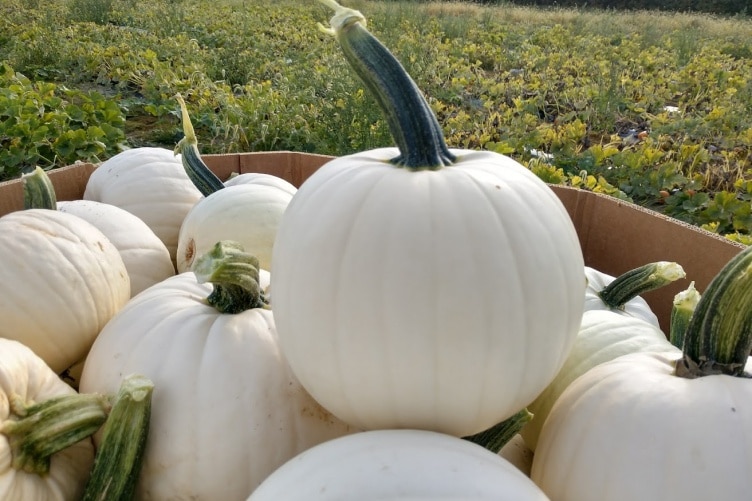Pumpkins are synonymous with Halloween. At the NH Agricultural Experiment Station at UNH, researchers have ensured that pumpkin lovers have plenty of variety to choose from, including the popular white pumpkins, when decorating for this spookiest holiday of the year.
For more than 80 years, UNH has made a substantial contribution to Halloween and autumn because of its breeding of new and often unique varieties of pumpkins. Currently under the direction of Brent Loy, professor emeritus and researcher with the NH Agricultural Experiment Station, of the 150 or so pumpkin varieties available from Northeast seed companies, more than 30 hybrid pumpkin varieties contain either one or two parental lines from UNH pumpkin breeding.
Loy’s experiment station-funded work, which has largely taken place at the experiment station’s Kingman Research Farm, Woodman Horticultural Research Farm and Macfarlane Research Greenhouses, has resulted in more than 80 new varieties of cucurbits — squash, pumpkins, gourds, and melons — sold in seed catalogs throughout the world. Along with cucurbit breeding introduced by the late A.F. Yeager in 1940, this breeding research represents the longest continuous squash and pumpkin breeding program in North America.
According to UNHInnovation, UNH has executed more than 50 exclusive licenses for inbreds and hybrids developed by Loy. Throughout his career at UNH, more than 200 hybrids and inbreds have been licensed or utilized in trial and germplasm agreements. Royalties generated by this portfolio continue to increase each year, including an expected 10 percent increase from last year. Royalties have generated more than $2 million for the university since commercialization began of these varieties.
Recently, UNH has concentrated on developing different sizes of white pumpkins, and pumpkins with unique pigmentation such as yellow and tan. Moonshine was the first white pumpkin released from UNH, a medium-size pumpkin with a dark handle. Other white pumpkins containing a UNH breeding line are Blanco and Snowball, developed respectively by Seneca Vegetable Research and Hybrid Seed of New Zealand. Six additional white hybrid varieties, representing different size classes, have been released to Northeast seed companies for production and sale. All new hybrids have intermediate resistance to powdery mildew disease.
In the yellow class of pumpkin, UNH has developed Owl’s Eye, marketed by High Mowing Organic Seeds, and Sunlight and Mellow Yellow, both produced by Hybrid Seed. “Sunlight is one of my favorites because of its high productivity, good tolerance to powdery mildew, and attractiveness for sales when marketed with white pumpkins. It is excellent for face painting,” Loy said.
“In the standard orange class of pumpkin, there are a lot of varieties from which to choose, but the key is finding pumpkin varieties that have consistently good handles,” Loy said, explaining that the handles of many varieties fall down in this category, especially when growing conditions are challenging.
Secretariat, a relatively new variety containing UNH breeding, has a very robust stem and an appealing, slightly flattened shape. And an older variety, Racer, which has a UNH inbred line, still is popular in the 15 to 20-pound class, despite lacking resistance to powdery mildew.
This year saw two new UNH-developed varieties, Carbonado Gold (Rupp Seeds) and Renegade (Johnny’s Selected Seeds), hit the market. “Both look like real winners for the 15 to 20-pound pumpkin class. These two have nice ribbing, outstanding color, and most importantly, handles that resist shrinkage and breakage after harvest. Renegade has a slightly more robust handle than Carbonado Gold; whereas, the latter variety has earlier maturity,” Loy said.
Two years ago, Rupp Seeds introduced Bisbee Gold, another variety containing a UNH breeding line. In the 8 to 10-pound class, this pumpkin is an excellent size for younger children to carve. This variety also has superb color, a very robust handle, and is extremely productive. With the exception of Racer, all the above-mentioned varieties have intermediate resistance to powdery mildew.
“There does not seem to be an end to the new stream of varieties entering the market,” Loy said.
Source: Lori Wright/University of New Hampshire












